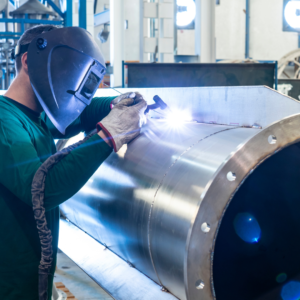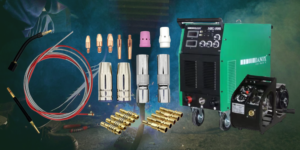When it comes to welding, there’s a method that stands out for its sheer power and versatility – ARC welding. If you’re curious about what makes ARC welding unique, how it differs from welding methods like TIG and MIG, and why it’s a top choice for numerous welding applications, you’re in the right place.
The Arc: The Heart of ARC Welding

At the core of ARC welding is the electric arc – a sustained electrical discharge that jumps the gap between the welding electrode and the workpiece. The result? An intense heat that melts both the electrode and the base metal, creating a molten pool that cools to form a solid, fused weld.
ARC welding goes by several names, including Shielded Metal Arc Welding (SMAW) or Manual Metal Arc Welding (MMAW). It is celebrated for its simplicity, reliability, and its capacity to weld a wide array of materials.
Why Doesn’t ARC Use a Torch Like TIG & MIG?

Unlike TIG and MIG welding, ARC welding doesn’t employ a welding torch. In TIG and MIG welding, a torch plays a pivotal role in delivering the electrode and shielding gas to the welding zone. In contrast, ARC welding relies on the electrode for both conducting the electric current that generates the arc and serving as the filler material.
This simplicity is one of ARC welding’s strengths. The absence of an additional torch makes it a cost-effective and straightforward welding method. Furthermore, this simplicity enhances portability, making it a preferred choice for outdoor and on-site welding projects.
Components Used in ARC Welding
In ARC welding, several key components are employed:
- Electrode:
This is the consumable or non-consumable rod that conducts the electric current and creates the It also acts as the filler material in the weld. - Electrode Holder:
This device clamps onto the electrode and allows the welder to maneuver it and maintain electrical - Earth Clamp:
Also known as ground clamp, this component connects the workpiece to the welding machine’s It ensures a complete electrical circuit.
Pros & Cons of Choosing ARC Welding
PROS | CONS |
VERSATILITY ARC welding can be used on a wide range of materials, including steel, cast iron, stainless steel, and more. | SPATTER ARC welding can produce more spatter compared to some other processes, necessitating more post-weld cleanup. |
PORTABILITY The equipment is relatively compact, making it suitable for on-site and outdoor welding. | SKILL REQUIRED While relatively straightforward, achieving high-quality welds with ARC welding does require practice and skill. |
HIGH PENETRATION It excels at deep penetration, making it suitable for thick materials. | THIN MATERIALS UNSUITABLE It may not be the best choice for welding thin materials due to its high input. |
COST-EFFECTIVE ARC welding is one of the most affordable welding processes, ensuring accessibility for a broad spectrum of users. |
Exploring the World of ARC Welding
ARC welding may not require a torch like TIG and MIG welding, but its simplicity, power, and versatility make it a formidable welding technique. Whether you’re an experienced welder or just embarking on your welding journey, understanding ARC welding opens up a world of possibilities.
At Danox Welding, we offer a range of ARC welding equipment, including ARC welding machines, electrodes, and accessories, to help you master this robust welding method. Explore our products and discover the sparks and strength of ARC welding for yourself.
DANOX ARC250 INVERTER DC ARC WELDER
✓ High efficiency & energy saving
✓ Good shaping & less deformation
✓ Comes with Earth Clamp & Electrode Holder




